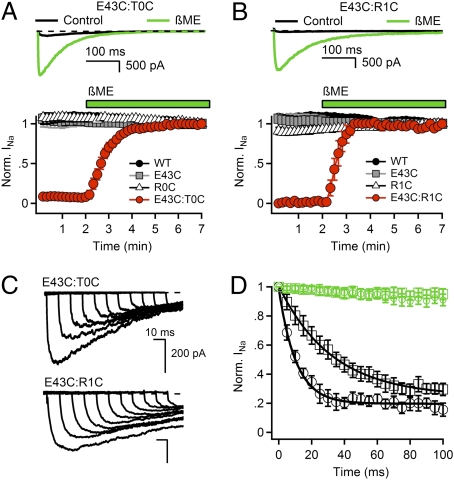Fig. 1.
Disulfide locking of the voltage sensors in the resting state of E43C:T0C and E43C:R1C channels. (A and B) Upper: INa from the first pulse in control conditions (black) and last pulse in the presence of reducing agent (green) elicited by a 0.1-Hz train of 500-ms depolarizations to 0 mV from a holding potential of −140 mV. Lower: Effects of 10 mM βME on the mean normalized peak currents (±SEM) recorded during trains (n = 6). (C) Rate of relocking in the resting state. E43C:T0C and E43C:R1C channels were unlocked by a 5-s pulse to −180 mV in the presence of 2 mM βME. Cells were then returned to βME-free solution for 5 min, depolarized to −120 mV for 0, 10, 20, 30, 40, 50, 60, 70, 80, 90, and 100 ms, and INa was measured by a 500-ms test pulse to 0 mV. (D) Rates of relocking of the voltage sensors in the resting state at −120 mV. βME (2 mM) was removed (black) or retained (green) during this phase of the experiment. Mean normalized peak currents are plotted vs. time at −120 mV (±SEM, n = 4). E43C:T0C (black circles), τ = 10.3 ms; E43C:R1C (black squares), τ = 32.5 ms; E43C:T0C + βME (green circles); E43C:R1C + βME (green squares).

